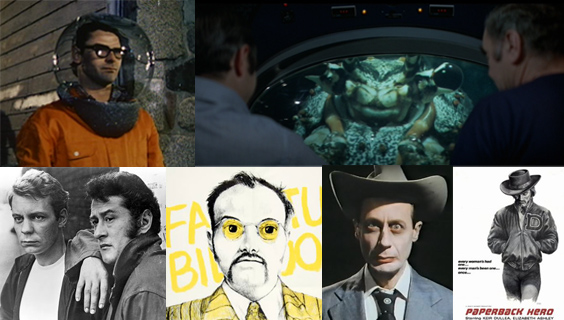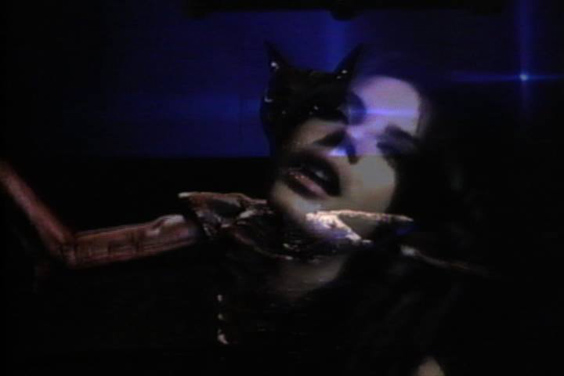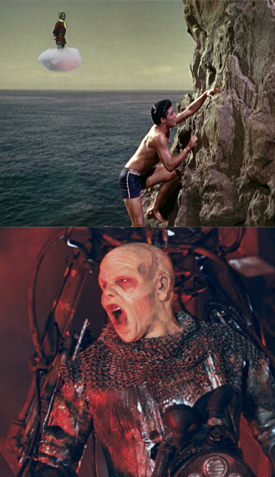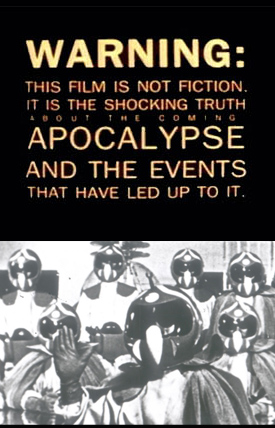Discovering the voice of the Canadian subconscious in “Taking Shelter”
Taking Shelter (2014) is a collage film constructed by found footage artist Jonathan Culp using over 400 Canadian feature length films made from 1970 to 1989, that is, films made under the Canadian “tax shelter,” a turbulent era of Canadian film in the 1970s and early ’80s where the government offered significant tax incentives to filmmakers.[i] This film is a labour of love made over the course of seven years, borrowing from hundreds of rare and long-abandoned films, many of which only exist in the subconscious space reserved for movie memories from late-night Canadian television.
The narrative in Taking Shelter is structured around observations made by alien visitors to earth. To reduce the complex narrative to its most basic premise: a group of lost aliens make contact with earth and in their confusion mistake Canada for America (an obvious mistake since many of the tax shelter films use Canadian cities to stand in for American cities). Culp further uses this style of meta-narrative (involving numerous subplots and genre-tropes) to explore the identity crisis that the Canadian film industry faced during the tax shelter era, a transformative decade in which the landscape of Canadian cinema changed, sparking much debate from both politicians and critics. As Benjamin Wright observes in Canada’s Great Shame: Tax Shelters, Nationalism, and Popular Taste in Canadian Cinema, the tax shelter era is marked by the Canadian Film Development Corporation’s desire to both “turn a profit, and also satisfy the nationalist and prescriptive mandates of politicians, critics, and media scholars who yearned for a cinema that was proudly and distinctly Canadian.” Of course, trying to turn a profit meant attempting to emulate Hollywood’s genre-style cinema and resulted in the production of a large number of relatively low-budget Canadian films during this period.
In many ways, Taking Shelter shares affinities with Craig Baldwin’s found footage masterpiece Tribulation 99: Alien Anomalies Under America (1991) and Soda_Jerk’s recent anti-copyright opus Hollywood Burn (2006). Hollywood Burn constructs a complex narrative using mainstream Hollywood films in which a league of video pirates battle Moses and his Copyright Commandments. In an attempt to challenge contemporary copyright laws, the pirates travel back in time to construct an Elvis Presley video-clone. Like Culp’s film, this featurette-length video took several years to make and employs an experimental strategy involving the composite character. Composite characters are characters constructed using several actors. Toronto-based video artist Aleesa Cohene has described this cinematic device as “single individuals made from many different people’s actions, gestures, dialogue, and so on.”[ii] For example, consider Todd Solondz’ Palindromes (2004) where the 13-year-old main character, Aviva, is played by ten different actors all of different ages and races. In the case of Taking Shelter, the film “stars” Christopher Plummer, Donald Sutherland, Jackie Burroughs, Samantha Eggar, Ken James, Jennifer Dale, Lawrence Dane, Henry Ramer, Michael Ironside, Carole Laure and Maury Chaykin all playing different roles in different films and yet each constituting a single character in Culp’s narrative. Similar to Hollywood Burn, Culp also collages spoken text in order to construct dialogue. For instance, the alien observers, comprised of Overdog (Michael Ironside) from Spacehunter: Adventures in the Forbidden Zone (1983, Lamont Johnson), the aliens from Starship Invasions (1977, Ed Hunt) and the robot from The Shape of Things to Come (1979, George McCowan) all speak using dialogue collaged from various tax shelter films.
Tribulation 99 is a “pseudo-pseudo-documentary” which bombards the viewer with information to induce a state of paranoia. Baldwin constructs a meta-narrative using industrial films, graphs, cartoons and movies from Hollywood B to Mexican Z, blending both the real and the absurd to explore America’s invasion of Latin America.[iii] In Taking Shelter, Culp employs strategies similar to Baldwin, however, it could be argued that the film induces a state of passive resistance instead of paranoia. In contrast to Tribulation 99, which is structured through the use of title cards, one of the strengths of Taking Shelter is that the film only uses the original footage to evoke narrative, in other words, it does not use any extra-diagetic commentary – neither voice-over nor titling. By not using any additional commentary, Culp is, in essence, allowing these films to speak for themselves.
Some of the pleasure derived in watching Taking Shelter results from recognizing the source material which runs the gamut of distinctly Canadian cult classics such as Goin’ Down the Road (1970, Donald Shebib), Paperback Hero (1973, Peter Pearson), Crime Wave (1985, John Paizs), Big Meat Eater (1982, Chris Windsor), Strange Brew (1983, Rick Moranis & Dave Thomas) and The Adventure of Faustus Bidgood (1986, Andy Jones) to low budget genre films such as Cannibal Girls (1973, Ivan Reitman), Deathdream (1972, Bob Clark), The Neptune Factor (1973, Daniel Petrie) and My Bloody Valentine (1981, George Mihalka). Beyond the narrative Culp developed in Taking Shelter, the film can also be seen as an attempt to re-claim and re-evaluate an era of cinema considered by some to be shameful or “subsidized junk”, that is, Taking Shelter ultimately celebrates the diverse films made under the Canadian tax shelter. Although the film suffers from some minor technical deficiencies due to the varying quality of the source material, Culp’s dedication to this ambitious project and the spirit in which the film was made can only be admired.

Clockwise from top left: ‘Big Meateater’ (1982); ‘The Neptune Factor’ (1973); ‘Paperback Hero’ (1973); ‘Crimewave’ (1985); ‘The Adventures of Faustus Bidgood’ (1986); and ‘Goin’ Down the Road'(1970)
Culp’s ambitious found footage film Taking Shelter could not have found a more appropriate premiere, launching on Canada Day at Toronto’s legendary underground cinema, coffee bar & bicycle repair shop, CineCycle.
Wednesday, July 1 – 8:00pm
Cinecycle, 129 Spadina Ave., Toronto
$10
See the Facebook event HERE: https://www.facebook.com/events/1599822430235155/
Taking Shelter – trailer from Jonathan Culp on Vimeo.
++++
Special thanks to Brian Random for his insightful conversations about cinema and trash culture while thrift store hunting in the suburbs of Toronto and to Cameron Moneo for his friendship and conversations about art and cinema which have made my life infinitely more meaningful.
[i] The Canadian “tax shelter” officially began in 1975 when the Canadian Film Development Corporation made a new tax incentive increasing the Capital Cost Allowance for the production of a Canadian feature film to 100%, meaning that film productions could defer paying taxes on their investment until the film began to generate a profit (although a focus on funding films that would be financially viable had already developed by the early ’70s). Of course, this lead to a substantial increase in the production of Canadian films, however, the tax incentive was eventually abused, leading to the end of the “tax shelter era” in 1989. For a succinct timeline of the Canadian tax shelter years, see Jonathan Culp’s research here: http://cinertia.blogspot.ca/2014/11/see-this-blog-isnt-really-dead-recently.html
[ii] In an interview with Brett Kashmere titled “At first cozy, became transgressive: Brett Kashmere Interviews Aleesa Cohene.”
[iii] In “Found Footage Film as Discursive Metahistory: Craig Baldwin’s Tribulation 99,” Michael Zryd constructs a persuasive argument that Tribulations 99 “less represents history than analyzes the historical discourses and political forces that motivate historical events.”

 June 27, 2015
June 27, 2015 










Wednesday? I’ll be there. Thanqueue Clint Enns. Nicely laid out. Faskinatin’!
10 yearss ago